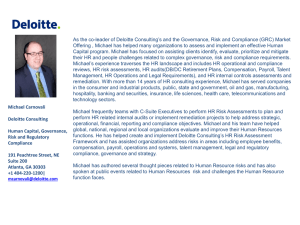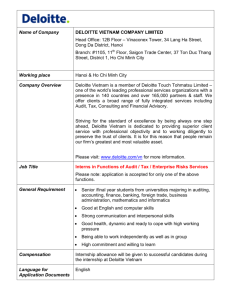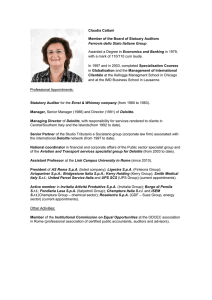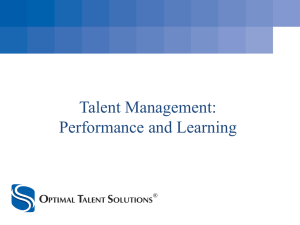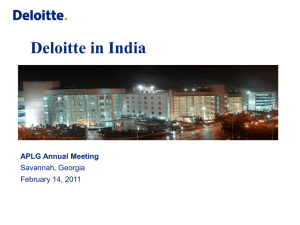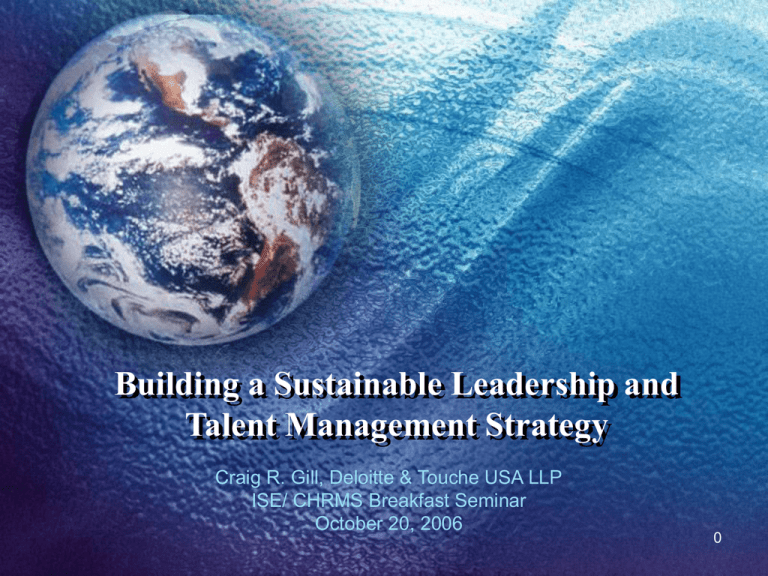
Building a Sustainable Leadership and
Talent Management Strategy
Craig R. Gill, Deloitte & Touche USA LLP
ISE/ CHRMS Breakfast Seminar
October 20, 2006
0
Agenda
1. The Talent Challenge Ahead: Beyond Demographics
2. Effective Leadership and Talent Management Strategies
3. Sustainability: Becoming Part of the Business Cycle
4. Lively Discussion and Debate
Copyright © 2005 Deloitte Development LLC. All rights reserved.
1
1. The Talent Challenge Ahead: Beyond Demographics
Assertions:
Demographic shifts in the workforce are real
They pose both a threat and an opportunity
Sustainability lies in expanding and realizing potential
Copyright © 2005 Deloitte Development LLC. All rights reserved.
2
Demographic shifts in the workforce are real
We know that…
– The Baby Boomers are aging (some of us)
– There is lower population growth in most developed nations
– The workforce is becoming more diverse (gender, race,
national origin)
Labor Force Make-Up Percentage
Change By Age Group
Labor Force Percentage Change
By Age Group
Labor Force Growth Rates
Percentage Change
(projected 2002-2012)
(projected 2002-2012)
(projected 2002-2012)
30%
2002
2012
19%
65 +
55 to 64
20%
45 to 54
- 9%
25 to 34
10%
0
16 to 24
Total
16-24 25-34 35-44
45-54
Total
12 %
White
8.5 %
44%
11%
Black
35 to 44
8%
7%
12%
Hispanic
Asian
19.3 %
32.6 %
50.8 %
55+
Source: U.S. Bureau of Labor Statistics
Copyright © 2005 Deloitte Development LLC. All rights reserved.
3
Demographic shifts in the workforce are real
…and there is a skills gap in developed countries…
Western Europe
• By 2050, 60% of the working age
population will be people over 602
• Germany has seen engineering
graduation rates decline by a third since
19952
U.S.
• The US Department of Education estimates
that 60% of all new jobs in the 21st century
will require skills that only 20% of the
workforce possess1
• US colleges and universities will graduate
only a fraction of the number of scientists and
engineers that will retire through 20181
1
2
3
4
Japan and South Korea
• Within 10 years, 26% of the Japanese
population will be over 65 years old 3
• By 2050, the percentage of the South
Korean’s over the age of 60 will jump to
41% of the population from 14% today, an
increase of more than 300% 4
Corporate Leadership Council, Managing the Workforce Planning Process, August 2004
Deloitte Research
Corporate Leadership Council
Hewitt International Report, October 2003
Copyright © 2006 Deloitte Development LLC. All rights reserved.
4
Demographic shifts in the workforce are real
…while wage inflation and attrition in emerging markets is decreasing
their attractiveness as an alternative labor market…
China
• Only 50% of Asian executives believe the
supply of skilled labor is adequate
• Labor force will begin to decline by 20171
Eastern Europe
• Difficulty fielding critical talent due to cultural
assimilation into the business; limited
experience working in a multi-national
organization; inadequate people management
and communication skills4
1
2
3
4
China Population and Development Research Center
Innovation in Emerging Markets, Deloitte Research, 2006
“HR Considerations For Entering The Asian Labor Market”, CLC, June 2005
“Resourcing in Eastern Europe”, Feb 2004, CLC
Copyright © 2006 Deloitte Development LLC. All rights reserved.
India
• Salaries for supervisory positions rose 20% in
2005 2
• Indian companies are increasingly focused on
developing employees to drive retention as the
war for talent grows increasingly competitive3
5
Demographic shifts in the workforce are real
…and larger costs of social benefits compete for funding of traditional
talent management programs
• While U.S. wage growth remains flat relative
to inflation other employee costs, such as
health care benefits, continue to rise rapidly1
• Top five adjustments manufacturing
organizations are likely to make over the
next 12 months to cover the costs of
employee healthcare coverage2:
U.S. Health Care Costs per Employee
10%
9.2%
9.9%
2005
2006 est.
8%
6%
4%
2%
0%
1
2
1.Increase expectations of employee
productivity
2.Increase the costs of consumer
services/products
3.Decrease other employee benefits
(e.g., retirement benefits, retiree
health care coverage, pension, etc.)
4.Decrease hiring of new staff
5.Decrease employee salaries/raises
Hewitt Associates
Society of Human Resources Management (SHRM)
Copyright © 2006 Deloitte Development LLC. All rights reserved.
6
Demographic shifts pose a threat and an opportunity
• Threats:
•
•
•
•
Skilled job migrating to developing countries – public policy issues
Unmanaged immigration into developed countries
Reduction/loss of traditional pensions and paid healthcare
Pushing the same buttons and expecting different outcomes
• Opportunities:
• U.S. remains healthy, active and growing – strength in our diversity
• Pension/healthcare portability offers a new employment deal -- from
“indentured” to “free agents”
• Impetus to innovation – SUVs or hybrids?
Copyright © 2005 Deloitte Development LLC. All rights reserved.
7
Sustainability lies in expanding and realizing potential
We have choices:
• Create less, or different, work (reengineer, automate, export work)
• Add more skilled workers (import talent)
• Get more out of the people we’ve got (increase yield)
Copyright © 2005 Deloitte Development LLC. All rights reserved.
8
Sustainability lies in expanding and realizing potential
Challenges to increasing the yield:
• Rising expectations – will this create dissatisfaction?
• Diminished ambition – will this work against businesses?
• What do workers want?
• Who’s going to manage this?
Copyright © 2005 Deloitte Development LLC. All rights reserved.
9
2. Effective Leadership and Talent Management Strategies
Assertions:
Traditional talent management is not up to the challenge
A new model focuses on develop, deploy and connect
Role of the “people manager” is essential
Goal of leadership development is sustainability
Copyright © 2005 Deloitte Development LLC. All rights reserved.
10
Traditional talent management is not up to the challenge
Acquire
Develop
Deploy
Retain
Largely a function of Assignments for
training expenditures
“A” Players
Heavy reliance on external
Driven by compensation
recruitment to meet
benchmarks and surveys
immediate needs
Deficiencies
• Minimal alignment with business strategy
• Less effective given labor market realities
• Does not maximize the “yield”
Copyright © 2006 Deloitte Development LLC. All rights reserved.
11
A new model focuses on develop, deploy, connect
1. Develop
2. Deploy
Acquire
Retain
3. Connect
Develop
Build capability
through on-the-job
learning
Deploy
Broaden and
deepen capability
through stretch assignments
Connect
Create networks and highquality relationships that
maximize performance
Advantages
• Focused on productivity of critical talent
• Creates dividends for acquisition and retention
Copyright © 2006 Deloitte Development LLC. All rights reserved.
12
A new model focuses on develop, deploy, connect
In an environment of skills shortages and limited resources,
the focus must shift from managing “A” players to “A” positions
From “A” Players
How do we support
our top performers?
To “A” Positions
How do we
support our most
critical
positions?
A Critical Workforce SegmentBased Talent Strategy
Copyright © 2006 Deloitte Development LLC. All rights reserved.
13
A new model focuses on develop, deploy, connect
Building a critical workforce segment strategy: example
Business Unit Strategic Plan
Build new technologies
Grow Asia
Sales and
Marketing
HR, Finance, IT,
Supply Chain
Business
Development
HR Business
Partner
AP Analyst
Global Key
Account Mgr
Sales
Analyst
Technology
Platform Mgr
Demand
Planning Mgr
Strategic
Support
Core
Support
Critical
Position
Strategic
Support
Critical
Position
Strategic
Support
For Core Support Positions
For Critical Positions – regardless of level
• Reduce talent investments or outsource
• Increase access to investments and
For Strategic Support Positions
build talent by feeding from strategic
• Maintain investments and buy talent
support positions
Copyright © 2006 Deloitte Development LLC. All rights reserved.
14
A new model focuses on develop, deploy, connect
Workforce planning focuses HR programs levers that will most
effectively meet the business demand for critical talent
1. Talent Demand
Forecast
Driven by business
plans and workforce
attrition
3. Talent Management
Objectives
4. Talent Management
Programs
2. Talent Supply
Forecast
Internal and
external labor
market factors
Serves to define:
• Future business demand for critical talent
• Opportunities presented by the external market
• Potential to maximize existing talent
Copyright © 2006 Deloitte Development LLC. All rights reserved.
15
A new model focuses on develop, deploy, connect
Workforce Planning Example: conducting workforce planning for Product
Engineers
• Reduce attrition
• Increase transfers in
60
40
Promo In
Voluntary
Attrition
Trans In
• Improve productivity
• Increase promotions
Reduced
attrition
Reduced
attrition and
productivity
Trans/
Promo Out
20 Incremental
Demand
External
Hires
Reduced
external hires
0
FY06
Copyright © 2006 Deloitte Development LLC. All rights reserved.
FY07
FY08
16
A new model focuses on develop, deploy, connect
Develop: Ensuring that critical workforce segments are
acquiring cutting edge skills to drive innovation
Capability
Develop
Deploy
Performance
Commitment
Alignment
Connect
Copyright © 2006 Deloitte Development LLC. All rights reserved.
• Formal training helpful for meeting
specific requirements
• Learning is social in nature - people
learn through their interactions with
others, especially when tasked with
real-life issues
• People are more committed to the
learning that occurs when they are
“tested” in ways that matter,
especially when they collaborate with
or are accountable to others
17
A new model focuses on develop, deploy, connect
Deploy: Strategic deployment of critical workforce segments
will enable intensified growth
Capability
Develop
Deploy
Performance
Commitment
Alignment
Connect
Copyright © 2006 Deloitte Development LLC. All rights reserved.
• People learn the most in jobs that
stretch them to grow, tap their
unique skills, and fuel their
imaginations
• The best organizations avoid
pigeonholing people based on the
confines of their resumes
• They also employ formal systems to
manage performance - And they
offer frequent dialogue and feedback
18
A new model focuses on develop, deploy, connect
Connect: Connecting talent in critical workforce segments
converts knowledge into productive action
Capability
Develop
Deploy
Performance
Commitment
Alignment
Connect
Copyright © 2006 Deloitte Development LLC. All rights reserved.
• People-to-People: Cultivate highperformance networks of highquality relationships (i.e., CoPs,
knowledge management programs)
• People-to-Purpose: Build and
sustain a sense of personal and
organizational mission
• People-to-Resources: Manage
knowledge, technology, tools,
capital, time, and physical space to
achieve professional and business
goals
19
Role of the people manager is essential
Why?
• Employee engagement/ attitudes key to performance1
• Employee engagement drivers are clear2
•
•
•
•
Challenging and exciting work
Career growth
Learning and development opportunities
Good boss
• “Best Places to Work” highly correlated to management practices
1.
2.
Copyright © 2005 Deloitte Development LLC. All rights reserved.
Corporate Leadership Council, 2005
Career Systems International; Towers Perrin
20
Role of the people manager is essential
Evolving role of “Management”:
• From jobs, to skills and outcomes – rethinking the nature of work
• From managing performance, to coaching and building commitment
• From “30 years at hard labor”, to using flexibility as a business
advantage
1.
2.
Copyright © 2005 Deloitte Development LLC. All rights reserved.
Corporate Leadership Council, 2005
Career Systems International; Towers Perrin
21
Goal of leadership development is sustainability
Best practices are clear; execution is mixed:
• Only 34% report being effective at identifying future leaders1
• Rigor and objectivity key in identifying and developing successors2
• P&L management or P&L-like work
• Executive talent management focused on replicating high-quality leaders
1.
2.
Copyright © 2005 Deloitte Development LLC. All rights reserved.
Conference Board
Charan, Harvard Business Review
22
3. Sustainability: Becoming Part of the Business Cycle
Assertions:
CEOs are under fire, but “getting it”
Talent management is an essential part of business planning
HR is growing in importance, if…
Copyright © 2005 Deloitte Development LLC. All rights reserved.
23
CEOs are under fire, but “getting it”
Average tenure now 3-4 years. Great job--all you have
to do is:
•
•
•
•
•
•
•
•
Make the numbers, every quarter
Please the Board
Please everybody else
Have clean books (watch those stock options!)
Outwit the competition, everywhere
Find ways to keep growing
Not sleep
Stay balanced
• How do we get sustainable talent management on
their agendas?
Copyright © 2005 Deloitte Development LLC. All rights reserved.
24
Talent management is an essential part of business planning
Using the language and the rhythm of business:
• SYSCO retention strategies = 10 cents per share
• CareFirst HR in the strategy and business planning sessions
• Thomson business planning and succession cycle
Copyright © 2005 Deloitte Development LLC. All rights reserved.
25
HR is growing in importance, if…
…we envision and manage HR as a business
Consumer
Consumer Markets
Markets
Value
Value delivery
delivery better
better than
than
competitors
competitors
What Business
is HR In?
Enterprise Strategy
and Objectives
Human Capital Strategy to Achieve
the Enterprise Strategy
Talent
Talent Markets
Markets
Employer
Employer of
of choice
choice ––
Employees
Employees of
of choice
choice
High
Performance
Talent
High
Performance
Organization
Competitive
HR
Services
Financial
Financial Markets
Markets
Returns
Returns in
in excess
excess of
of
alternatives
alternatives
Dependable HR Controls
Public
Public Policy
Policy and
and
Reputation
Reputation
Conformity
Conformity with
with
expectations
expectations
Copyright © 2005 Deloitte Development LLC. All rights reserved.
26
HR is growing in importance, if…
…we lead talent management to the next level of
analytical rigor and results
• They are beginning to “get it”
• HR gaining access to “the table”
• What are we going to say once we get there: talent market
segmentation at Microsoft
Copyright © 2005 Deloitte Development LLC. All rights reserved.
27
In Summary
• Talent challenge opportunity to rethink work, value and meaning
(“work” as sustainable human enterprise)
• Talent management: hunting/gathering farming
– Biggest challenge: growing better “farmers”
• HR has to take the lead in making the business case
– Growing role of HR decision science: HR as “agronomist”
Copyright © 2006 Deloitte Development LLC. All rights reserved.
28
Your Turn…
Lively Discussion and Debate Time!
Copyright © 2006 Deloitte Development LLC. All rights reserved.
29
Thank You!
30


